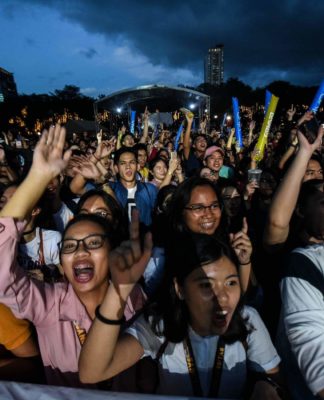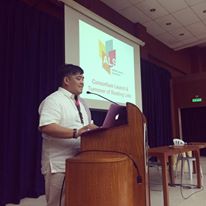DESPITE the construction of the two-story, 200-slot pay-parking complex, parking woes in the University of Santo Tomas persist.
Although, the area across the Central Library has been converted to 20 additional parking slots, the estimated 1,200 parking spaces allotted for students, administrators, and faculty members are still not enough to accommodate vehicle owners in UST. There are no plans by the University to assign the 20 parking spaces at the Thomas Aquinas Research Complex for the use of students.
The lack of parking areas in the University results in congested traffic inside the campus.
Limited space
UST Traffic Management Committee head Roberto Evangelista said, some 3,500 Thomasians registered last school year for car stickers. But this does not translate to one vehicle per person.
“Some register two to three vehicles, wala kasing limit ang application ng car stickers. Besides, hindi naman nila gagamitin lahat ng sasakyan nila in one day,” Evangelista explained.
Car stickers are issued in late June or early July. However, according to UST’s Traffic and Parking Guidelines, “the issuance of car stickers is neither a guarantee of availability of parking space at every instance nor does it entitle the holder to park beyond the hours of one’s legitimate business in the premises.”
Only vehicles with UST car stickers may park in UST assigned slots while students are allowed to park in the pay-parking complex, which accommodates mostly USTH patrons, only after 12 n.n. But during summer vacation, vehicles without UST car stickers are allowed to park in the University grounds.
Considering the University’s population, the availability of parking slots and the issuance of vehicle stickers are relatively small.
Although not all Thomasians issued with car stickers park inside the University, even Evangelista admits that parking spaces are still lacking.
Driver Joemari Salonga said he usually makes a full round of the University before he spots an available space.
When parking space is not available in UST, students are forced to park outside the University, at their own risk.
“Usually mga 7 a.m. ako dumarating para makahanap ng parking space. `Pag wala nang space sa loob, sa labas ng UST ako nagpa-park,” College of Science student Richard Einstein Chu said.
Crispin Guevarra, security personnel assigned at the pay-parking complex, said that since unregistered vehicles are now allowed to enter the two main lanes (the now two-way Lacson and España lanes), traffic in the campus may worsen.
But this can still be controlled since Evangelista said that cars without stickers are only allowed to reach a certain area inside the campus.
“Kapag lumampas sila, for example, sa UST Student Health Service (USTSHS), pinapabalik (pinapalabas) na sila (car owners without stickers),” he added.
Chain reaction
Guevarra said the unavailability of parking spaces causes traffic inside the campus.
“Ang traffic dito sa UST, nangyayari kapag napupuno ang parking spaces. Umiistambay, naghihintay ‘yung mga hindi makahanap ng space, nagkakaroon tuloy ng problema sa counter flow,” Guevarra explained.
Guevarra added that parking outside the designated lines and insistence of vehicle owners without car stickers to enter the University often clog traffic.
Customers of pay parking who refuse to park at the second level of the complex also contribute to the traffic burden.
“Dito sa pay parking, minsan ayaw mag-park sa taas kasi mainit, namimili pa, gusto rito sa ibaba (lang), kaya traffic,” Guevarra said.
Still, Evangelista does not discount that the heavy traffic flow in areas outside UST also causes traffic problems inside the campus.
“It is a chain reaction. There would be traffic inside the campus if they (vehicle owners) can not easily make their way out (of the campus),” Evangelista said.
Accountability
Plans to expand the parking spaces in the University are not feasible at present.
“There are no immediate plans to expand or add parking spaces here. It is not feasible to construct a multi-level parking here. We are not like malls that from morning until midnight may pumaparada. If we will construct a multi-level parking, where would the money come from?” Evangelista asked.
Currently, the Traffic Management Committee’s funds come from vehicle registration fees, parking and traffic violation fines, and parking fees.
Evangelista said, car sticker registration costs P300, a fixed rate since late ‘80s.
The violations are penalized with a P300 fine for the first offense, P600 for the second offense, and P1000 fine and/or confiscation of sticker and revocation of privilege for the third offense. Common traffic and parking violations in the University include illegal or overnight parking, blocking, impeding the flow of traffic, not yielding to pedestrians, disregarding street signs, idling of car engine, playing of loud music, and blowing of horns. Failure to post permanently and or transferring of car sticker is charged with a P300 fine and/or confiscation of privilege.
The UST pay parking charges P20 for the first five hours and P10 for every succeeding hour. Lost ticket is charged for P200.
The pay parking fee collection is handled by the UST Cashier’s Office.
Salonga said that the UST parking fee is reasonable while Chu said that the campus-parking fee is expensive.
“Medyo mahal `yung parking fee (sa UST) kasi sa labas, first three hours, P15 tapos P5 every succeeding hour,” Chu said.
Evangelista said that UST parking fee is still affordable. He showed the Varsitarian a ticket he had when he parked near the National Library (the parking service is under the Manila Traffic and Parking Bureau) that charged P20 for the first three hours and P15 for every succeeding hour.
“Ito ang mahal (Manila City Government supervised parking). `Yung sa labas ng UST, (kaya mura) kasi (baka) raket (ng barangay o sa city hall),” Evangelista said.
He added that the registration fee collection does not go directly to the University coffers, but is allotted for UST’s scholarship programs while the rest of the funds are spent on the University’s road clearing projects and for repainting traffic signs and directions.
Full compliance
Despite the parking woes and traffic blues in the University, Evangelista said that there is 100 percent compliance with parking and traffic rules and regulations from Thomasians.
“In my first two years in office, compliance (from Thomasians) was a wishful thinking, especially sa (USTH and USTSHS) medical staff. Nagtiyaga kami, na-implement naman (parking and traffic rules and regulations),” Evangelista said.
The parking and traffic rules and regulations cultivate discipline Thomasian vehicle owners.
“The students comply because if their vehicles were apprehended (because they do not have) a car sticker, chained ang auto nila. That is a lot of trouble to them, they do not want that,” Evangelista said. Ma. Lynda C. Corpuz and Bernardette S. Sto. Domingo














